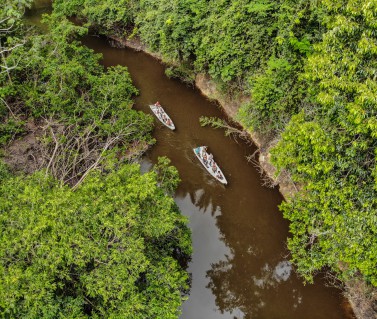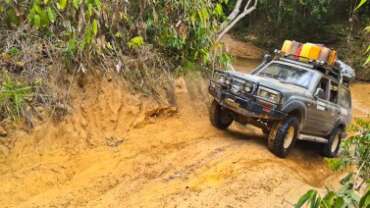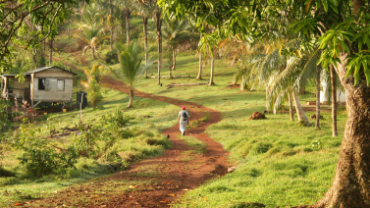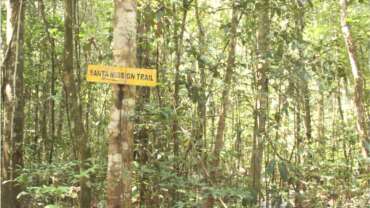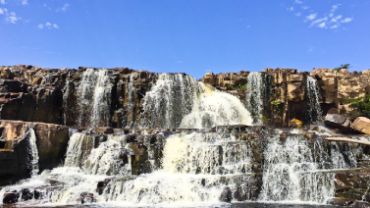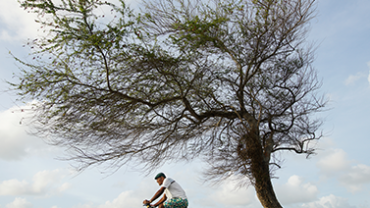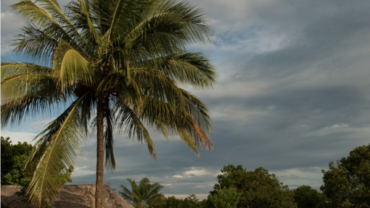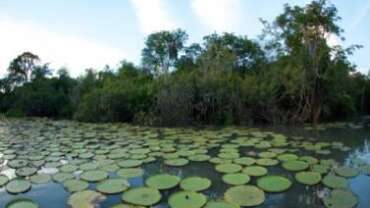Rivers & Creeks in Guyana
Guyana is known as the ‘land of many waters’ because of the numerous rivers that traverse long distances in the country, before finally spilling into the Atlantic Ocean in the north. The Essequibo, Demerara, Berbice and Corentyne are the most important ones, rising in the highlands or mountains of the country. The rivers and their tributaries create rich ecosystems for flora and fauna and offer travellers immersive experiences in nature.
The Demerara River Region
Originating in the thick central rainforests of Guyana, the Demerara River flows over 340 kilometres north before it spills into the Atlantic Ocean. This is the smallest of Guyana’s main river systems, and it is one of the busiest as it is used to transport goods to Georgetown from abroad and to Linden upstream. Tan in colour, the river is full of silt that extends far into the deep blue ocean. Along its route, it channels into different tributaries and creeks, creating islands that are inhabited and completely uninhabited. The banks of the river ring with bird calls and local life are a mere sample of the rich inland biodiversity.
MONUMENTS & MUSEUMS
There are several monuments located within or in close proximity to Georgetown and the Demerara River, making them perfect for a day trip of monument hopping. Embark on a journey into Guyana’s heritage by visiting some of these historical sites.
Guyanese Heritage Museum
A window into Guyana’s history, Garry Serrao’s private museum is a passionate collection of utensils, stamps, Dutch and British glassware, books, objects of daily use and other artefacts. The two floor museum offers a step back in time. Being located in a private home, makes it all the more fun as you saunter around.
Mahaica River Tour
You do not have to venture deep into the rainforest to see the exquisite birdlife of Guyana. Just travel 45 minutes from the capital of Georgetown to the Mahaica River, from where you can take a boat into nature. The main draw lies in gazing at the national bird, the Hoatzin, which is found near the banks of the river. Even if you are not a passionate birder, the green canopy and fresh air never disappoints.
Demerara Harbour Bridge
As the main thoroughfare between the east and west banks of the Demerara River, this pontoon bridge is a staple on the itinerary during a trip to Georgetown. The most exciting part of cruising over the mile and a half long bridge is to get on one side and see small and large vessels cross under it. Retractor spans in the centre of the bridge open up and allow vessels to sail through. If you want to experience the bridge at its most atmospheric, try to visit it at dusk and see the Stabroek Market light up in the distance.
Linden & Around
Historically a bauxite-mining town, Linden’s attractions stem from its vantage location. The town is the gateway to the central rainforest region. As the second largest town in Guyana, it houses several interesting museums and heritage sites. The Linden Museum of Socio-Cultural Heritage is particularly good at throwing a spotlight on the Indigenous life and the bauxite history of the region. Linden’s industrial heritage comes alive in the Christianburg Waterwheel. This was part of a hydro-powered sawmill to increase logging efficiency. Stroll through the town to gaze at the remnants of the colonial architecture in St. Matthew’s Church, Watooka House and St. Aidan’s Anglican Church. Linden is also home to the Blue Lakes which are very popular with the locals.
Rockstone
Just out of Linden, Rockstone Village offers a staggering number of nature-based activities. The rustic ambience adds to the ‘back to nature’ experience. Birdwatching, canoeing, swimming in the river and the lure of great sport fishing (especially during the Rockstone Fish Festival) are just a handful of reasons to visit. Birds chirping and sounds of the rainforest are a constant background score here.
The Essequibo River Region
As the largest river in Guyana, the Essequibo has a long and winding journey of over 1000 miles from the Acarai Mountains near the border with Brazil to the Atlantic Ocean. Along its path, its many tributaries enrich an unrivalled ecosystem of waterfalls, rainforest and amazing wildlife. After circling around hundreds of islands, this remarkable river skirts the town of Parika for the last few miles before draining into the vast ocean.
Historical and Cultural Sites
The Essequibo’s massive water highway is filled with many of Guyana’s smaller islands. One of the biggest draws to this area, and to the islands specifically, are the unique historical and cultural sites you can find.
Fort Island
Located at the mouth of the Essequibo River, the island bears an imprint of the Dutch in the form of two important structures – the Court of Policy and Fort Zeelandia. Take a walk through the Court of Policy, which was built in 1752, and learn more about this time in Guyana. This is the oldest non-military structure in Guyana and has donned many hats as a store, a church, court, and now a well-curated museum. A short walk away from here is Fort Zeelandia, an 18th century brick fort, which was one of the very first buildings constructed in the country. Though the fort is relatively small, it was vital as a defensive fortification.
Fort Kyk-Over-Al
A brick arch on a grassy island on the Essequibo River is the only remaining part of the Dutch fort that kept other European enemies at bay. Kyk-Over-Al translates to ’see over all’ in Dutch, referencing the expansive view of the entire riverfront from this spot. Stand here and let your imagination take you back in time, when Dutch soldiers would have intensely guarded this region. Now, only a handful of travellers visit for photo-ops.
Hogg Island
The battle between ‘Hogg’ and ‘Hog’ is constant when you ask locals about the original name of the largest island on the Essequibo. Some attribute it to hundreds of wild hogs that once occupied it. Another explanation points to it being named after Quintin Hogg, an Englishman who helped to modernise sugar production. Regardless, the island is a beautiful one with one main hook – the Hogg Island Windmill. The 36-foot Dutch structure was built with clay bricks on what used to be Plantation Luyksberg.
Leguan Island
Leguan Island will give you a taste of life on a river island. As one would guess, it is easy paced. You can stroll through the main street, watching rice stalks swaying in the breeze. A stroll away from the main jetty lies the 200-year-old St. Peter’s Anglican Church, which was built in the early 19th century. The photogenic church and the laid-back ambience of the island are perfect for a day trip.
Saxacalli
The inspiration of the name of this Arawak village comes as no surprise. The word Saxacalli translates to ’kingfisher’ – and there are plenty around the Essequibo. It is one of the oldest communities in the region, having been established before the Dutch arrived in these parts. Cassava making, local life, a handicraft centre and a beach bordered by white sand are the biggest draws of the village. Saxacalli Beach is a great spot for swimming and relaxing.
Mazaruni Prison
While wending down the Essequibo towards Bartica, one can spot the Mazaruni Prison in the distance. It lies across from the Penal Settlement and Susan Island. Not quite a tourist attraction but good for some intriguing stories during a guided trip along the river as you pass by.
Eddy Grant’s House
The famous musician’s fans never tire of gawking at his small island conclave set right in the middle of the Essequibo on the way to Bartica. Grant’s holiday home has an atmospheric location, perhaps contributing to the inspiration for his songs.
Guyana’s Other Popular Rivers
The fact that the rivers of Guyana are mentioned in the country’s national anthem is reason enough to know that you will have several excursions along these wonderful water highways. The moniker, ‘land of many waters’, come alive as you cross the numerous rivers, creeks and streams that flow throughout its length and breadth. The Essequibo, Demerara and Berbice are the largest and most important rivers of the country, but there are several others that support life around them.
Berbice
Rising from the southeast of Guyana, the Berbice River travels for 595 kilometres through dense rainforests before passing through New Amsterdam and eventually flowing into the Atlantic Ocean. Aiding commerce on its tributaries and a plush ecosystem for wildlife, Berbice is one of the most important rivers of Guyana.
Burro Burro
The closest tryst with the Burro Burro River for any traveller is with the hosts of the Surama Eco-lodge in the North Rupununi region. The river can be accessed from the lodge by traversing a dense jungle trail for an hour. For nature and adventure enthusiasts, the river landing becomes the basecamp for multi-day river and camping tours, fishing, caiman spotting and birdwatching.
Corentyne
The Mazaruni River is another tributary of the Essequibo River. Originating in the far-reaching forests of the Pakaraima Mountains and the Roraima plateau, it eventually meets the Cuyuni River near Bartica. Apart from being a rich source of alluvial gold, the river is home to a number of fish species. black electric eels (numfish), piry (piranha), haimara, baiara and lau-lau fish are abundantly found in these waters, along with Anacondas.
Rupununi
A tributary of the Essequibo, the Rupununi River originates in the Kanuku Mountains in the southern part of Guyana. Sharing a watershed with the Amazon, the Rupununi River is rich in biodiversity and a popular cruising highway for travellers to get close to nature. It is flanked by savannah, wetlands, forest, and the Kanuku Mountains Protected Area, offering a great aquatic ecosystems for many regions.
Cuyuni, Mazaruni & Other Rivers
Cuyuni
A tributary of the Essequibo River, the Cuyuni makes a long and arduous journey from the Guiana Highlands of Venezuela from where it drops through tropical rainforests to meet the Mazaruni near Bartica. Weekenders from Georgetown often visit the resorts on the river, immersing themselves in the abundant greenery around its banks.
Mazaruni
The Mazaruni River is another tributary of the Essequibo River. Originating in the far-reaching forests of the Pakaraima Mountains and the Roraima plateau, it eventually meets the Cuyuni River near Bartica. Apart from being a rich source of alluvial gold, the river is home to a number of fish species. Black electric eels (numfish), piry (piranha), haimara, baiara and lau-lau fish are abundantly found in these waters, along with anacondas.
Mahaica
Like most rivers of Guyana, the Mahaica also drains into the Atlantic Ocean. But before that, it offers the perfect environs for birdlife. In fact, the Mahaica’s waterway is a popular weekend getaway from Georgetown for birding enthusiasts. The river is also a sportfishing hotspot, given its rich biodiversity and access from the capital.
Rewa River
The Rewa River of Guyana offers access to a virtually untouched part of the country with pristine natural environment. A tributary of the Essequibo, it runs for kilometers through the heart of the nation and joins the Rupununi River at Rewa Village. The river’s adjoining areas are home to a long list of animals featuring jaguars, tapirs, giant river otters, monkeys, capybaras, giant armadillos, caimans, giant river turtles, pumas, peccaries, anacondas and agoutis. Many large species of river fish, including tiger fish, piranha, arawana, payara and peacock bass can be found here.



